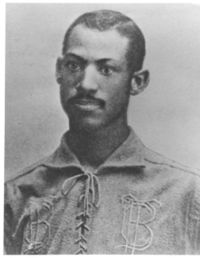In honor of Black History Month I want to share a story that was written by Karen and Kevin Flynn.
Dates carry an importance for us, birthdays and anniversaries are remembered and cherished. In sports, dates also carry significance. Fans can easily tell you when a promising rookie made his first major league start or a dramatic home run secured a post-season berth. These are memories which bring fans together and can span generations.
Perhaps in the future, a date in the District will be set aside to honor the day the color barrier was broken in the nation’s capital. This took place on June 7, 1884, when Toledo arrived in town to play a three-game series with the Washington Association Club. On the roster were Moses Fleetwood Walker and his brother Welday.
The Washington National Republican wrote in its June 7 edition: “The Toledos meet the Washingtons at Athletic Park this afternoon for the first time. The Toledos are a strong team, as is fully evident by their having warmed the Baltimores yesterday to the tune of 4 to 2. Walker, the noted colored catcher of the Toledos, will play today, and will no doubt serve to attract many desirous of witnessing the colored man and brother in this new field of labor.”
The Washington Association Club had several advantages going into the 1884 season. It had the only established ball park in town, thanks to the involvement of Lloyd Moxley, and the best pitcher, Bob Barr. Holly Hollingshead was a respected former player and the club had help from the league in signing players.
The challenge by Henry Lucas of the Union Association would see a record 34 major league franchisees in operation in 1884. Talent was scarce and a call was even sent out west to California, “Come east, young players.” Whole franchises like the 1883 pennant winning Toledo franchise of the Northwestern League were absorbed into the major leagues.
By the time Toledo came to town, Washington was 4-20, their best players wanted out and the fans and press shifted their attention to Michael Scanlon’s Union Association club.
The first game, on June 7, was a 10-4 Washington win. The National Republican wrote, “Walker the colored catcher, caught Hank O’Day’s wild and swift pitching well, considering the formidable nature of the task.”
Moses Walker went 1 for 4 batting. In the field he made nine put outs, and four assists and was charged with one error.
The second game in the series on June 9 went to Toledo 6-1.
The Washington Evening Critic wrote, “The colored catcher of the visitors distinguished himself by catching the wild balls of their pitcher.”
The Washington National Republican had this to say: Mullane and Walker gave a fine exhibition, working together to perfection, the lithe colored catcher doing his work without a mistake of his own. We now know that Walker had to work behind the bat without signs with Mullane in the box.”
The battery for Toledo, was future Hall of Famer Tony Mullane at P, Moses Walker-at C. Moses Walker went 0 for 4; he recorded seven putouts and one assist.
Toledo took the third game in the series on June 10, 7-2. With O’Day pitching for Toledo, Mullane was in right field. Moses Walker went 2 for 4, with two runs scored. He had eight putouts, four assists and an error. For the series Walker went 3 for 12 and was praised for his defensive work. He had 24 putouts, nine assists and two errors. His presence caused no recorded protests or problems.
There are other dates and events that should be acknowledged.
One year later, on July 22, 1885, the Washington Eastern League Club traveled up to Harrisburg for a league game. Harrisburg, which just recently joined the league, featured infielder Frank Grant, the noted ballplayer. Grant played third and went 1 for 4.
In 1887, the Washington Capitol City Club of the National Colored Base Ball League was established. The Capital Citys were admitted on May 6, but played no league games, since the league disbanded 16 days later because of lagging attendance. The Capital City Club did play several exhibition games after the league collapsed. On their roster were Frank C. Leland, a young outfielder and Fisk University graduate.
It should be noted that early on Washington had several notable African American teams, such as the Alerts, featuring Frederick Douglass Jr., and the 1875 Washington Mutuals. The Cuban Giants during the 1880s and into the 1890s had annual spring exhibition games in Washington against the various league clubs.
Sadly, by the 1890s the gains made by African Americans were eroded by what is collectively called the Jim Crow era. The achievements of players like Moses Fleetwood Walker and Sol White faded from view, with some publications going as far as stating that no African American had ever played major league baseball.
This came from researching our second book on Baseball in the District. The third book, An Orphan in an Upstart League, 1901 to 1904, is nearing completion.






